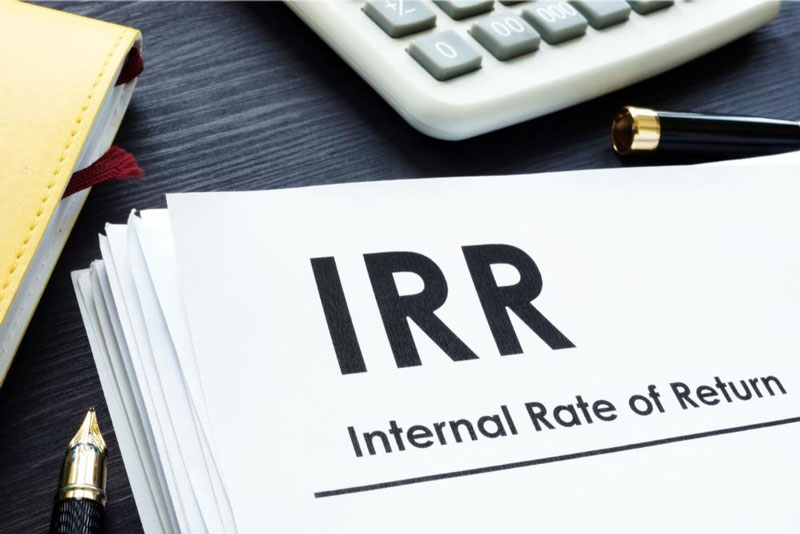For most investors, the goal of investing isn't to just create a steady stream of income but to increase their money for the future. And for some investors, increasing their money can involve being aware of and balancing a multitude of different factors like risk, liquidity, and taxes.
In this blog post, we’ll break down two key concepts that are important for understanding how returns on investments—return on investment (ROI) and internal rate of return (IRR)—relate to one other in terms of future earnings-both short-term and long-term.
What is Return on Investment and Why is it Important?
Return on investment (ROI) is a return measure that compares the profit earned by investment to the amount of money invested. ROI can be used to evaluate the performance of assets that are purchased or those that are reinvested. For example, if a company's stock returns 50% and the initial investment was $500, then the investor earned a profit of $250. The percentage increase in profitability—the investor earned exactly half ($250) of his original investment—can be measured in terms of ROI.
Return on investment: a measure comparing profit to cost; compare [to] actual interest rate (ie, discount rate).
ROI compares a project's income to the costs needed to generate it. If the resulting ROI value is greater than zero, then profits are being earned on the initial investment (i.e. the "return on investment").

What is an Internal Rate of Return (IRR)?
An IRR is the compound annual percentage interest earned by an investor in a single period over and above the cost paid plus interest paid in that same time span.
How is the Internal Rate of Return Measured?
The internal rate of return is a single, annualized interest rate that encompasses all loan or investment terms in a simple number. Although that might sound confusing, an IRR function in Excel can do it for you in one quick and easy calculation.
Why is IRR Important?
The internal rate of return is important for several reasons. First, it provides a specific number for every single project to evaluate. Second, it can be used as a means of comparing different investments using the same data and calculating the most profitable project on an annual basis. Third (and finally), IRR can be used to compare projects of various time intervals and even different qualities.

How Can IRR be Used?
The internal rate of return is useful in evaluating projects and determining the most profitable project. For example, an investor might want to decide how to allocate his investment portfolio across different projects. IRR can help determine which project has the highest return on investment—and thus evaluate each project according to its own merits. An investor could also determine how much of a certain investment should be allocated to each individual project, which is known as a multi-period decision. Or an investor may want to compare the total return from different projects over time, which can be done with more complex compounding formulas such as Excel's IRR function. IRR can also be used to compare two or more investments of the same quality but at different time intervals.
There are a few special cases that need to be taken into account when calculating IRR, namely:
- "One-time" cost items such as initial investment costs, business purchases, and other "one-time" costs should be discounted before calculating internal rates of return. Discounted cash flow models should also be used when calculating internal rates of return in order to take into account the future tax implications of the project. When using IRR in Excel, you must take into account compounded interest in order to correctly calculate the IRR function.
- IRR is most useful when comparing projects with different time scales (e.g. over a shorter time interval) such as a month, a quarter, a year, or even more. IRR cannot be used to compare projects where there is a change in the interest rate (e.g. from fixed to floating rate).
- IRR does not allow for future compounding effects as well as ordinary cumulative returns do (e.g. making the same investment at different points in time).
An example of calculating an internal rate of return using the IRR function would be:
In this example, we have $115,000 that we invest in three projects over three years with varying rates of return and cost factors.
Year 1: $115,000 invested in project 1 with a rate of return of 2%.
Year 2: $115,000 invested in project 2 with a rate of return of 3%.
Year 3: $115,000 invested in project 3 with a rate of return of 4%.
Difference between ROI AND IRR?
The main difference between ROI and IRR is that the former simply looks at the profit gained after a payment, whereas the latter takes into account the performance of security before the initial investment. However, both ROI and IRR are important measurements that can be used in investment plans to determine whether they are successful or not.
IRR helps quantify what "normal" investors expect to see when they reinvest their money or investments (in other words, they're looking for a specific rate). This means that when working with clients who have long-term goals it is important to help them set realistic expectations for performance.
The internal rate of return (IRR) is the discount rate that makes any lump sum equal to a stream of equal payments at regular intervals over some time period.
So what does this mean and why do investors care about it?
Investors, who are looking for a more comprehensive way of evaluating their investments to ensure they are on track with the expected rate of return on investment, may find IRR to be the most useful method for "judging" a security's performance. This is because it looks at both the benefits and costs associated with an investment over time.




